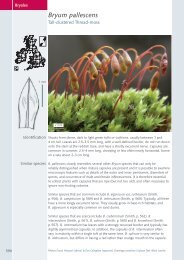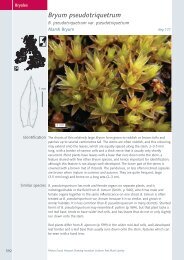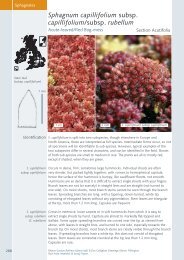Bryum marratii - BBS Field Guide
Bryum marratii - BBS Field Guide
Bryum marratii - BBS Field Guide
Create successful ePaper yourself
Turn your PDF publications into a flip-book with our unique Google optimized e-Paper software.
582<br />
Bryales<br />
Nerve ends<br />
below blunt<br />
leaf tip<br />
1 mm<br />
Identification<br />
Similar species<br />
<strong>Bryum</strong> <strong>marratii</strong><br />
Baltic <strong>Bryum</strong><br />
1 mm<br />
2 mm<br />
B. <strong>marratii</strong> 1 mm<br />
Photos David Holyoak Drawing Jonathan Graham Text Mark Lawley<br />
Beaked lid<br />
B. <strong>marratii</strong><br />
B. <strong>marratii</strong><br />
This is one of several very uncommon <strong>Bryum</strong> species with blunt-tipped leaves. Its<br />
shoots form rather bright green patches 2–10 mm tall. Leaves are very concave,<br />
blunt-tipped, oval-oblong, about 0.75–2 mm long and up to 2.5 times longer than<br />
wide. Capsules are uncommon, maturing in autumn. They are only about 1.5 mm<br />
long, and no more than 1.5 times longer than wide, with a beaked lid.<br />
B. <strong>marratii</strong> occurs mainly at the upper edge of saltmarshes, whereas the even<br />
rarer B. calophyllum (Smith, p. 540; also see photographs on opposite page) prefers<br />
base-rich coastal sands, particularly in dune slacks. Small plants can be difficult<br />
to distinguish, but the leaves of B. calophyllum are more strongly bordered and<br />
somewhat shorter relative to their length (about twice as long as wide), often with<br />
a tan to pinkish colour. The best distinction between these two species is that the<br />
capsules of B. calophyllum (which mature in autumn and winter) are about twice<br />
as long as wide, with a bluntly conical lid.<br />
Another rare species, B. cyclophyllum (Smith, p. 547) also has wide, bluntly tipped<br />
leaves that are somewhat concave; it is a much softer plant than the common<br />
Rhizomnium punctatum (p. 616), with a less well-defined leaf border. Filamentous<br />
gemmae sometimes occur in the leaf axils, but capsules are unknown in Britain.<br />
It grows on moist, bare soil, especially in the inundation zones of large lakes and<br />
reservoirs.
3 mm<br />
2 mm<br />
B. neodamense 5 mm<br />
Bluntly<br />
conical lid<br />
Bryales<br />
Bryales<br />
B. calophyllum<br />
B. calophyllum<br />
The rare B. muehlenbeckii (Smith, p. 586) appears to consist of unusual forms<br />
of B. alpinum (p. 599) that have grown partly or entirely submerged. It has bluntly<br />
tipped, concave leaves, and forms green, or red-tinged tufts or patches 2–7 cm tall<br />
on acidic rocks in and near water courses in the mountains. The lower part of the<br />
stems is covered by long rhizoids which may bear orange-red tubers identical to<br />
those of ordinary B. alpinum. Capsules are not known in Britain.<br />
Rare forms of B. pseudotriquetrum (called B. neodamense in Smith, p. 566; also see<br />
photograph above) occurring in base-rich sites that are prone to flooding, have leaves<br />
which are concave, bluntly tipped and do not run down onto the stem, but resemble<br />
those of ordinary B. pseudotriquetrum (p. 592) in being rather evenly spaced along<br />
the stem and are distinctly bordered.<br />
Habitat<br />
B. <strong>marratii</strong> grows mainly at the upper edge of saltmarshes, and rarely on dune slacks.<br />
583





